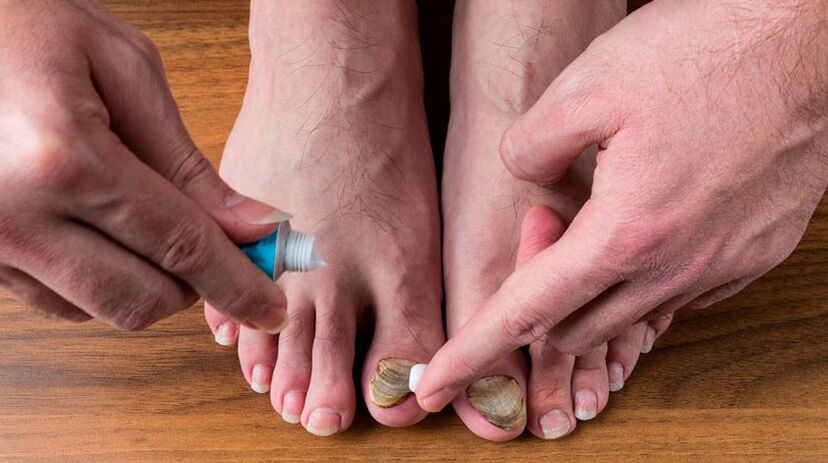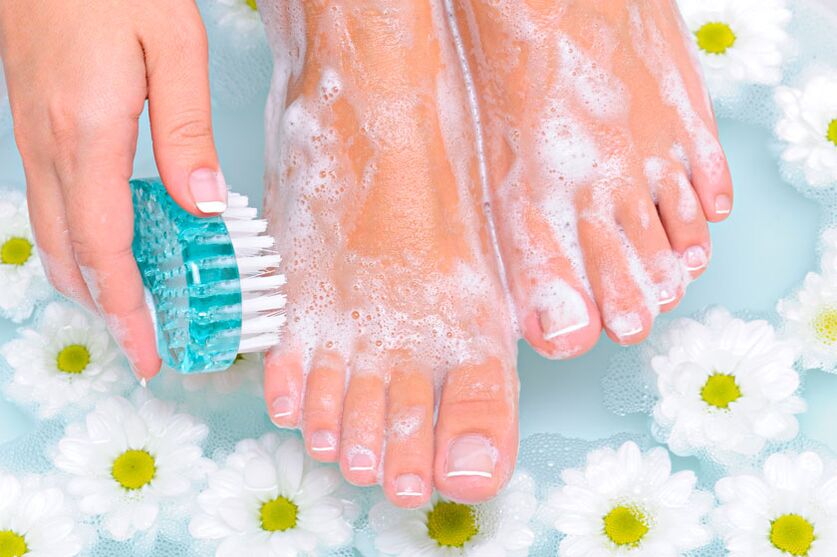
In summer we travel a lot, visit public beaches, visit swimming pools and showers. Sometimes we are even taken on long sea voyages where we have to use public beaches or toilets for better or worse. These are all places with increased buildup of infections and where you can get nail fungus frequently. Treatment is far from easy, but do not despair - you can still get rid of the fungus on your nails!
Nail fungus is a common condition that usually starts with a small spot under the tip of the nail. It comes in both white and yellow. Contrary to popular belief, the fungus occurs on both legs and hands. If it is not noticed in time, the fungal infection will begin to spread more deeply. Over time, the fungus can cause discoloration, thickening, and crumbling of the nail plate. This can affect several neighboring nails, even if only one was initially infected.
If the condition is mild and doesn't bother you, you may not need serious treatment. If you have severe pain from nail fungus, popular care tips and various medications can help. Take care of your feet, because nail fungus often returns even with successful treatment. Another popular name for the fungus is onychomycosis (on-ih-koh-my-KOH-sis). And the condition in which the fungus affects the area between the toes and the skin of the feet is known as foot mycosis (tinea pedis).
Symptoms of the appearance of a fungal infection
Even if you've never come across nail fungus and have no idea what it looks like, you'll never miss out on this excruciating itch. It will not be superfluous to use some kind of infection prescription for prevention so that the process does not get going. As a result, many people recommend using vinegar to disinfect the area where the fungus is likely to invade. The main symptoms of nail fungus and athlete's foot are:
- Itching in the area of infection;
- Changed color of the nail plate;
- Cleavage and fragility of the nail;
- Painful sensations on the foot.
Effective treatment should be started at the very first symptoms of nail fungus, special creams and ointments with an antifungal effect will help you. The essence of professional remedies for getting rid of fungal infections on the feet is that they not only eliminate the symptoms, but also destroy the very source of the infection.
A fungal infection can develop in people of any age, but is more common in the elderly. With age, the nail can become brittle and dry. The resulting cracks on the nails allow fungi to penetrate inside. Other factors, such as reduced blood circulation in the legs and a weakened immune system, can also play an important role in increasing the likelihood of infection.
A fungal infection on the feet can start with athlete's foot (athlete's foot) and then spread from one toe to the other. At the same time, you are unlikely to get infected with a fungus from someone, you are more likely to take them in contact with the environment in a public place.
Risk Factors and Complications
Type 1 and type 2 diabetes are uncomfortable factors that can increase your risk of getting a yeast infection. Diabetes often causes circulatory disorders in the legs and can cause numbness due to nerve damage. It significantly increases the risk of cellulite, dry feet, cracks and injuries. Due to the poor condition of the skin, blood vessels, and nerve fibers, any relatively minor foot injury, including a fungal nail infection, can lead to more serious complications. See your doctor if you have diabetes and suspect you have a fungus.
Factors That Can Increase Your Risk of Developing Nail Fungus:
- Circulatory disorders
- Heavy sweating
- A story of a sports foot
- Damage to skin or nails
- Skin conditions (such as psoriasis)
- Any type of diabetes
- Weak immunity
Do not start treatment, because after a severity the fungus can be painful and cause irreversible damage to the skin and nail plate. Be especially careful if you suspect that the body's immune strength is low, as the damage caused by the fungus is difficult to repair. That is why it is so important to cure the fungus as soon as possible in a timely manner.
The main treatment methods

Unfortunately, such a problem as fungal infection of nails and skin occurs not only in adults, but also in children. Our grandmothers used the oldest and probably fastest way to get rid of the infection - vinegar. For a bowl of water you need a glass of 9% table vinegar. Such baths are able to kill fungal spores and prevent their spread. Keep in mind that this procedure can be very painful for irritated or damaged areas of the skin.
Contrary to popular belief, spores can not only affect the skin of the legs, but can also easily linger on the arm or other parts of the body. The sooner you use the most effective means of caring for a damaged area, the faster you can heal it. Fungal nail infections can be difficult to treat. Talk to your doctor if self-care strategies and over-the-counter products haven't helped. Treatment will depend on the severity of your condition and the type of fungus causing it. It can take months to see results. And even if the condition of your nails improves, reinfections are not uncommon.
Antifungal drugs are available both topically and orally. They are often the first choice because they clear the infection faster than topical medications. The action of these funds is aimed at accelerating the growth of the nail plate and faster detachment of the affected part. It usually takes 6-12 weeks for the fungus to completely disappear. The end result will be felt when the healthy nail grows back. In addition, the older the patient, the weaker the treatment outcome. Adults over 65 may have a longer recovery time and may require additional topical medications.
Oral antifungal drugs are not widely used because they can have various side effects. Therefore, if the disease is not at an advanced stage, doctors try to work with external means. Blood tests are recommended to determine the exact dose of the drug. Doctors may not recommend oral medications for people with liver disease, heart failure, or people taking certain medications. After all, common side effects from them are rashes, liver damage.
Another means of eradicating disease is antifungal nail polish. You apply it to infected nails and the surrounding skin once a day. After seven days, wipe the applied layers with alcohol, then start new applications. You may have to use this nail polish every day for almost a year.
Another treatment option is an antifungal cream, which must be rubbed into infected nails after soaking. To improve the effectiveness of creams, it is best to thin your nails first. The thinner layer helps the medicine penetrate and destroy the fungus. In this procedure, the stratum corneum is diluted with urea and then removed with a file or other instrument.
The most effective folk remedies

Homemade vinegar ointment
The most powerful remedy that will help get rid of the fungus is vinegar and an egg. An excellent ointment is obtained from them, which promotes tissue healing and softening of the affected nail area. A raw chicken egg is placed in a jar with vinegar and then placed in a dark cupboard until the essence dissolves the shell. Then you need to remove the film and mix the vinegar, oil and egg together. Ointment is applied to the steamed legs, cellophane progresses and the effect of a bath is created. Then the affected softened area is removed and the ointment is reapplied the next day.
Garlic lotion
Garlic is a powerful natural antibacterial and antifungal agent. It helps to remove fungal lesions in the most gentle way, even in advanced cases. Garlic juice is mixed with alcohol in a ratio of 1: 1 and diluted with distilled water. With this lotion, it is necessary to lubricate all affected skin and nail areas at night until the fungus has completely died. This lotion is effective even in advanced cases.
Mint compress
Peppermint is an excellent remedy for fungi. The essential oils of peppermint have been shown to be effective against fungi, lamblia and staphylococci. Traditional medicine believes that treating the fungus with herbs is the same effective method as using ointments. Fresh plant leaves or essential oil are best for a compress. If they are made from fresh leaves, then you need to grind the mint with salt and apply it to the sore nail. If the fungus is in an uncomfortable place on the arm or leg, it is better to secure it with a bandage. The essential oil is suitable for greasing damaged areas.
Copper sulfate ointment
Another popular method is to use copper sulfate to fight fungus and infection. It is part of many antifungal ointments, but it can also be used as a stand-alone remedy. If you do not have the opportunity to buy an ointment from a pharmacy, then you can do it yourself. Use tar or goose fat to create a greasy base, add a teaspoon of sulfur and copper sulfate there. Copper sulfate must first be calcined in a pan until it turns white or gray. It is necessary to smear the sore spots on the legs or hands with this ointment every evening.
Iodine against toenail fungus
In an emergency, ordinary iodine, which can always be found at home, will help fight the fungus. It works great on wounds, but few know that just a drop of iodine can prevent fungal infections of the foot from developing. This is the best remedy for the first manifestations of nail fungus. It is applied directly to the nail plate at night, then put on socks, until the morning iodine is absorbed into the nail. The process must be repeated for at least two weeks.
Athlete's foot prevention
Remember that the prevention of fungus is possible with folk remedies for the foot. So if you suspect a fungus, use vinegar or iodine. The following habits can help prevent nail fungus or re-infection:
- Wash your hands and feet regularly. Wash your hands after touching an infected nail. Moisturize your nails after washing them.
- Cut your nails straight, smooth the edges with a file, file down the thickened areas. Disinfect your nail clippers after each use.
- Wear sweat-wicking socks or change them during the day.
- Choose shoes made from breathable materials.
- Throw away old shoes or treat them with disinfectants and antifungal powders.
- Wear shoes around the pool, in the changing rooms and in public areas.
- Choose a nail salon that uses sterile nail tools for each client.
- Throw away nail polish and fake nails.

















